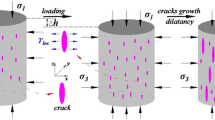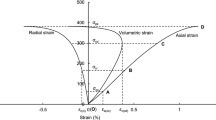Abstract
In this study, a new model is presented for the dilation angle of rocks which deform through brittle mechanisms in laboratory compression tests. This model, which is defined by a smaller number of independent parameters than similar models, is shown to fit laboratory test data for a wide variety of rocks (sedimentary rocks, diabase, marble, granites, and quartzite). A detailed investigation of each model parameter is performed, and potential links to geological and geotechnical properties are made. A mechanistic interpretation of the observed dilation angle data is also presented, in the context of the new model. Model parameters for the rock types studied are presented, and recommendations for parameter determination/estimation are made. The key strength of the model is shown to be its flexibility to accommodate a data-poor or data-rich analysis, as well as a simplified or comprehensive implementation. Practical guidance for model modifications is provided.














Similar content being viewed by others
References
Alejano LR, Alonso E (2005) Considerations of the dilatancy angle in rocks and rock masses. Int J Rock Mech Min Sci 42:481–507
Archambault G, Roleau A, Daigneault R, Flamand R (1993) Progressive failure of rock masses by a self-similar anastomosing process of rupture at all scales and its scale effects on their shear strength. In: Proceedings of the second international workshop on scale effects in rock masses. Lisbon, p 133–141
Arzua J, Alejano LR (2013) Dilation in granite according to servo-controlled strength tests. Int J Rock Mech Min Sci 61:43–56
Arzua J, Alejano LR, Walton G (2014) Strength and dilation of jointed granite specimens in servo-controlled triaxial tests. Int J Rock Mech Min Sci 69:93–104
Ashby MF, Sammis CG (1990) The damage mechanics of brittle solids in compression. Pure Appl Geophys 133:489–521
Besuelle P, Rudnicki JW (2004) Localization: Shear bands and compaction bands. In: Gueguen Y, Bouteca M (eds) Mechanics of fluid-saturated rocks. Elsevier, Boston, pp 219–321
Bieniawski ZT (1968) Fracture dynamics of rock. Int J Fract Mech 4(4):415–430
Brace WF, Paulding BW, Scholz C (1966) Dilatancy in the fracture of crystalline rocks. J Geophys Res 71:3939–3953
Carter J, Diederichs MS, Carvalho JL (2008) Application of modified hoek-brown transition relationships for assessing strength and post-yield behaviour at both ends of the rock competence scale. In: Proceedings of the 6th international symposium on ground support in mining and civil engineering construction. Cape Town, South Africa, p 325–338
Chandler HW (1985) A plasticity theory without Drucker’s postulate, suitable for granular materials. J Mech Phys Solids 33:215–226
Chandler NA (2013) Quantifying long-term strength and rock damage properties from plots of shear strain versus volume strain. Int J Rock Mech Min Sci 59:105–110
Cook NGW (1970) An experiment proving that dilatancy is a pervasive volumetric property of brittle rock loaded to failure. Rock Mech 2:181–188
Costin LS (1985) Damage mechanics in the post-failure regime. Mech Mater 4:149–160
Crouch SL (1970) Experimental determination of volumetric strain in failed rock. Int J Rock Mech Min Sci Geomech Abstr 7:231–241
Detournay E (1986) Elastoplastic model of a deep tunnel for a rock with variable dilatancy. Rock Mech Rock Eng 19:99–108
Diederichs MS (1999) Instability of hard rockmasses: The role of tensile damage and relaxation. Ph.D Thesis. University of Waterloo, Waterloo, Canada
Diederichs MS (2003) Rock fracture and collapse under low confinement conditions. Rock Mech Rock Eng 36:339–381
Diederichs MS (2007) The 2003 geotechnical colloquium: mechanistic interpretation and practical application of damage and spalling prediction criteria for deep tunnelling. Can Geotech J 44:1082–1116
Diederichs MS, Martin CD (2010) Measurement of spalling parameters from laboratory testing. In: Zhao J, Labiouse V, Dudt J-P, Mathier J-F (eds) Rock mechanics in civil and environmental engineering. Taylor & Francis Group, London
Diederichs MS, Kaiser PK, Eberhardt E (2004) Damage initiation and propagation in hard rock during tunnelling and the influence of near-face stress rotation. Int J Rock Mech Min Sci 41:785–812
Edelbro C (2009) Numerical modelling of observed fallouts in hard rock masses using an instantaneous cohesion-softening friction-hardening model. Tunn Undergr Space Technol 24:398–409
Farmer I (1983) Engineering behaviour of rocks. Chapman and Hall, New York
Hajiabdolmajid V, Kaiser PK, Martin CD (2002) Modelling brittle failure of rock. Int J Rock Mech Min Sci 39:431–741
Hansen B (1958) Line ruptures regarded as narrow rupture zones: basic equations based on kinematic considerations. In: Proceedings, conference on earth pressure problems, p 39–48
Hassani FP, White MJ, Branch D (1984) The behaviour of yielded rock in tunnel design. In: Proceedings, stability in underground mining II. Lexington, Kentucky
Hill R (1950) The mathematical theory of plasticity. Oxford University Press, London
Jaeger JC, Cook NGW (1969) Fundamentals of rock mechanics. Methuen and Co., Ltd., London
Kaiser PK, McCreath DR, Tannant DD (1996) Canadian rockburst support handbook. Geomechanics Research Centre/MIRARCO, Sudbury
Kaiser PK, Diederichs MS, Martin CD, Sharp J, Steiner W (2000) Underground works in hard rock tunnelling and mining. In: Proceedings, ISRM international symposium. Melbourne, Australia
Kawamoto T, Ichikawa Y, Kyoya T (1988) Deformation and fracturing behaviour of discontinuous rock mass and damage mechanics theory. Int J Numer Anal Methods Geomech 12:1–30
Kwasniewski M, Rodriguez-Oitaben P (2012) Study on the dilatancy angle of rocks in the pre-failure domain. In: Qian Q, Zhou Y (eds) Harmonising Rock Engineering and the Environment. Taylor & Francis, London
Labuz JF, Biolzi L (1991) Class I vs. class II stability: a demonstration of size effect. Int J Rock Mech Min Sci 28:199–205
Lajtai EZ (1998) Microscopic fracture processes in a granite. Rock Mech Rock Eng 31:237–250
Lubliner J (1990) Plasticity theory. Macmillan Publishing Company, New York
Martin CD (1997) Seventeenth Canadian geotechnical colloquium: the effect of cohesion loss and stress path on brittle rock strength. Can Geotech J 34:698–725
Martin CD, Chandler NA (1994) The progressive fracture of Lac du Bonnet granite. Int J Rock Mech Min Sci Geomech Abstr 31:643–659
Medhurst TP (1996) Estimation of the in situ and deformability of coal for engineering design. Ph.D Thesis. University of Queensland, Brisbane, Australia
Mogi K (1966) Pressure dependence of rock strength and transition from brittle fracture to ductile flow. Bull Earthq Res Inst 44:215–232
Perras MA, Diederichs MS (2014) A review of the tensile strength of rock: concepts and testing. Geotech Geol Eng 32:525–546
Price AM, Farmer IW (1979) Application of yield models to rock. Int J Rock Mech Min Sci Geomech Abstr 16:157–159
Read HE, Hegemeier GA (1984) Strain softening of rock, soil and concrete—a review article. Mech Mater 3:271–294
Riedel JJ, Labuz JF (2007) Propagation of a shear band in sandstone. Int J Numer Anal Methods Geomech 31:1281–1299
Roscoe KH (1970) Tenth rankine lecture: the influence of strains in soil mechanics. Geotechnique 20:129–170
Rowe PW (1971) Theoretical meaning and observed values of deformation parameters for soil. In: Proceedings, Roscoe memorial symposium on stress–strain behaviour of soils. Cambridge, UK, p 143–194
Schmertmann JH, Osterberg JO (1960) An experimental study of the development of cohesion and friction with axial strain in saturated cohesive soils. In: Proceedings, research conference on shear strength of cohesive soils. Boulder, CO, p 643–694
Sture S, Ko HY (1978) Strain-softening of brittle geological materials. Int J Numer Anal Methods Geomech 2:237–253
Tapponnier P, Brace WF (1976) Development of stress-induced microcracks in Westerly granite. Int J Rock Mech Min Sci Geomech Abstr 13:103–112
Vardoulakis I, Sulem J (1995) Bifurcation analysis in geomechanics. Blackie, Glasgow
Vermeer PA, de Borst R (1984) Non-associated plasticity for soils, concrete, and rock. Heron 29(3):1–64
Walton G, Diederichs MS (2014) Dilation and post-peak behaviour inputs for practical engineering analysis. Geotech Geol Eng. doi:10.1007/s10706-014-9816-x
Walton G, Arzua J, Alejano LR, Diederichs MS (2014a) A laboratory-testing-based study on the strength, deformability, and dilatancy of carbonate rocks at low confinement. Rock Mech Rock Eng. doi:10.1007/s00603-014-0631-8
Walton G, Diederichs MS, Arzua J, Alejano LR (2014b) Verification of a lab-based dilation model for in situ conditions using continuum models. J Rock Mech Geotech Eng. special edition—advanced numerical modelling (in press)
Walton G, Diederichs MS, Arzua J (2014c) A detailed look at pre-peak dilatancy in a granite—determining “plastic” strains from laboratory test data. In: Proceedings, Eurock 2014. Vigo, Spain
Zhao XG, Cai M (2010) A mobilized dilation angle model for rocks. Int J Rock Mech Min Sci 47:368–384
Zhao XG, Cai M, Cai M (2010) Considerations of rock dilation on modeling failure and deformation of hard rocks—a case study of the mine-by test tunnel. Canada. J Rock Mech Geotech Eng 2:338–349
Acknowledgments
The authors would like to acknowledge the ongoing support of Dr. Leandro Alejano and Javier Arzua from the University of Vigo, Spain, as well as Denis Labrie at the CANMET laboratory in Ottawa, Canada. Thanks to Anna Crockford and Ehsan Ghazvinian for providing comments on the manuscript. This work would not be possible without funding from the Natural Sciences and Engineering Research Council of Canada and the Nuclear Waste Management Organization of Canada.
Author information
Authors and Affiliations
Corresponding author
Rights and permissions
About this article
Cite this article
Walton, G., Diederichs, M.S. A New Model for the Dilation of Brittle Rocks Based on Laboratory Compression Test Data with Separate Treatment of Dilatancy Mobilization and Decay. Geotech Geol Eng 33, 661–679 (2015). https://doi.org/10.1007/s10706-015-9849-9
Received:
Accepted:
Published:
Issue Date:
DOI: https://doi.org/10.1007/s10706-015-9849-9




